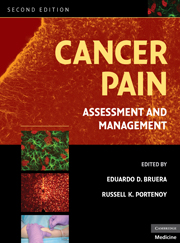Book contents
- Frontmatter
- Contents
- Contributors
- Preface
- SECTION I MECHANISMS AND EPIDEMIOLOGY
- SECTION II EPIDEMIOLOGY AND SYNDROMES
- SECTION III ASSESSMENT
- SECTION IV PHARMACOLOGICAL TREATMENT
- SECTION V OTHER INTERVENTIONAL STRATEGIES
- SECTION VI REHABILITATION AND PSYCHOLOGICAL INTERVENTIONS
- SECTION VII THE ROLE OF ANTINEOPLASTIC THERAPIES IN PAIN CONTROL
- SECTION VIII PAIN IN SPECIAL POPULATIONS
- SECTION IX DIFFICULT PAIN PROBLEMS
- 25 Cancer pain and depression
- 26 Neuropathic pain
- 27 Breakthrough pain
- 28 Bone pain
- SECTION X SYSTEMS OF CARE
- Index
- Plate section
- References
28 - Bone pain
from SECTION IX - DIFFICULT PAIN PROBLEMS
Published online by Cambridge University Press: 06 July 2010
- Frontmatter
- Contents
- Contributors
- Preface
- SECTION I MECHANISMS AND EPIDEMIOLOGY
- SECTION II EPIDEMIOLOGY AND SYNDROMES
- SECTION III ASSESSMENT
- SECTION IV PHARMACOLOGICAL TREATMENT
- SECTION V OTHER INTERVENTIONAL STRATEGIES
- SECTION VI REHABILITATION AND PSYCHOLOGICAL INTERVENTIONS
- SECTION VII THE ROLE OF ANTINEOPLASTIC THERAPIES IN PAIN CONTROL
- SECTION VIII PAIN IN SPECIAL POPULATIONS
- SECTION IX DIFFICULT PAIN PROBLEMS
- 25 Cancer pain and depression
- 26 Neuropathic pain
- 27 Breakthrough pain
- 28 Bone pain
- SECTION X SYSTEMS OF CARE
- Index
- Plate section
- References
Summary
Introduction
The skeleton is one of the most common sites of tumor metastases. Metastatic cancer invades bone in 60%–84% cases. Up to 80% of all bone metastases are related to cancer of the breast, prostate, lung, thyroid, and kidney. Multiple myeloma also is commonly associated with skeletal disease. Approximately 70% of patients with bone metastases develop pain. In addition to pain, metastatic bone disease results in immobility, frequent hospital admissions, pathological fractures, metabolic complications such as hypercalcemia, neurological abnormalities, and bone marrow infiltration and suppression. These devastating symptoms may have a prolonged effect and also have major psychosocial implications. Detection of bone metastases may be the first indicator that cancer has not been cured; bone is the first site of recurrence in up to 40% of women with breast cancer. Patients suffering from bone metastases secondary to breast cancer survive an average of 34 months, with a range of 1–90 months.
This chapter primarily discusses pain associated with bone metastases. It also addresses some of the recent developments in the prevention and management of osteolysis.
Pathophysiology of bone pain
The invasion of bone by tumor is well understood; however, the mechanisms of nociception are not well known. The three main mechanisms by which the skeleton is affected by cancer are primary bone cancer, direct invasion from adjacent primary tumors, and bone metastases. The last is by far the most common mechanism; primary tumors of bone are much less frequent.
- Type
- Chapter
- Information
- Cancer PainAssessment and Management, pp. 515 - 532Publisher: Cambridge University PressPrint publication year: 2009



